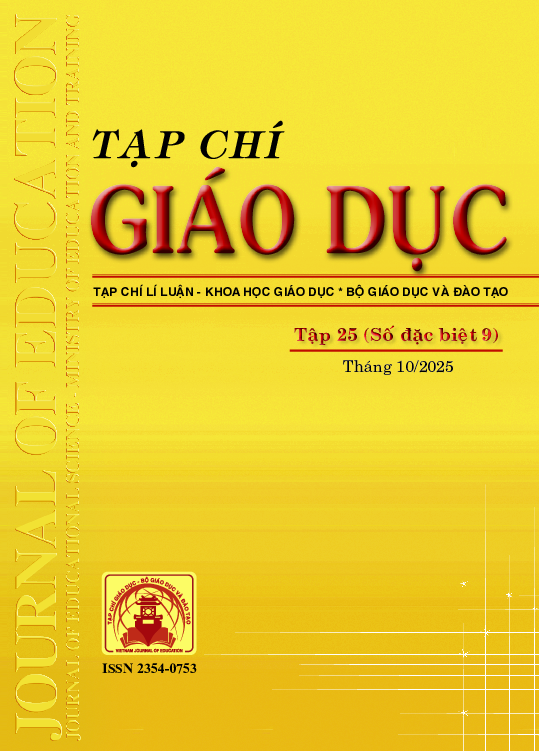Xây dựng khung năng lực tự học trong dạy học môn Toán sử dụng AI Chatbot kết hợp trò chơi hóa cho học sinh tiểu học
Tóm tắt
In the context of educational reform oriented toward the development of learner competences, self-study competency has emerged as one of the core competencies required of students in the new General Education Curriculum. The integration of AI chatbots and gamification in teaching presents significant potential for fostering self-study competency by providing immediate feedback, personalizing learning content, and enhancing students’ engagement and motivation. This study proposes a competency framework for self-directed learning tailored to primary school students in the context of mathematics instruction, designed in alignment with their developmental characteristics and grounded in the use of AI chatbot-supported, gamified learning. The proposed framework comprises four components and twelve criteria, each clearly described across distinct levels of performance. The DDI (Design, Development and Implementation) (Hinkin, 1995) research method was implemented in this study with 5 main stages in the scale development process, namely: creating an item pool, expert conclusion, application, factor analysis and reliability analysis (Sulasiwi et al., 2019). The development and application of this self-study competency framework aim to assess and effectively support students' self-directed learning, thereby contributing to improved mathematics instruction and meeting the competency standards set for students in general and for primary education in particular.
Tài liệu tham khảo
Bộ GD-ĐT (2018). Chương trình giáo dục phổ thông - Chương trình tổng thể (ban hành kèm theo Thông tư số 32/2018/TT-BGDĐT ngày 26/12/2018 của Bộ trưởng Bộ GD-ĐT).
Bộ GD-ĐT (2018). Chương trình giáo dục phổ thông môn Toán (ban hành kèm theo Thông tư số 32/2018/TT-BGDĐT ngày 26/12/2018 của Bộ trưởng Bộ GD-ĐT).
Bennani, S., Maalel, A., & Ben Ghezala, H. (2022). Adaptive gamification in E‐learning: A literature review and future challenges. Computer Applications in Engineering Education, 30(2), 628-642.
Bii, P. (2013). Chatbot technology: A possible means of unlocking student potential to learn how to learn. Educational Research, 4(2), 218-221.
Chang, D. H., Lin, M. P.-C., Hajian, S., & Wang, Q. Q. (2023). Educational design principles of using AI chatbot that supports self-regulated learning in education: Goal setting, feedback, and personalization. Sustainability, 15(17), 12921.
Cheng, S.-F., Kuo, C.-L., Lin, K.-C., & Lee-Hsieh, J. (2010). Development and preliminary testing of a self-rating instrument to measure self-directed learning ability of nursing students. International Journal of Nursing Studies, 47(9), 1152-1158.
Deterding, S., Sicart, M., Nacke, L., O’hara, K., & Dixon, D. (2011). Gamification: using game-design elements in non-gaming contexts. In CHI’11 extended abstracts on human factors in computing systems (pp. 2425-2428).
Garrett, M. (2017). Learning and educational applications of chatbot technologies. Australia: Cinglevue.-2017.-11 avgusta. https://www.cinglevue.com/learning-educational-applications-chatbot-technologies
González-González, C. S., Muñoz-Cruz, V., Toledo-Delgado, P. A., & Nacimiento-García, E. (2023). Personalized gamification for learning: A reactive chatbot architecture proposal. Sensors, 23(1), 545.
Hinkin, T. R. (1995). A review of scale development practices in the study of organizations. Journal of Management, 21(5), 967-988.
Kapp, K. M. (2012). The gamification of learning and instruction: game-based methods and strategies for training and education. John Wiley & Sons.
Khaleel, F. L., Ashaari, N. S., Meriam, T. S., Wook, T., & Ismail, A. (2016). The architecture of dynamic gamification elements based learning content. Journal of Convergence Information Technology, 11(3), 164-177.
Knowles, M. S. (1975). Self-directed learning: a guide for learners and teachers. Chicago: IL. Follett Pub. Co.
Lê Thị Thùy Linh, Đỗ Thị Phương Thảo (2023). Xây dựng khung năng lực tự học của học sinh tiểu học trong dạy học môn Toán theo mô hình Dạy học kết hợp. Tạp chí Giáo dục, 23(số đặc biệt 8), 79-83.
Lin, M. P.-C., & Chang, D. (2023). CHAT-ACTS: A pedagogical framework for personalized chatbot to enhance active learning and self-regulated learning. Computers and Education: Artificial Intelligence, 5, 100167.
Ng, D. T. K., Tan, C. W., & Leung, J. K. L. (2024). Empowering student self‐regulated learning and science education through ChatGPT: A pioneering pilot study. British Journal of Educational Technology, 55(4), 1328-1353.
Nguyễn Minh Giám (2024). Dạy học định hướng phát triển năng lực tự học môn Hóa học với sự hỗ trợ của công nghệ trí tuệ nhân tạo. Luận án tiến sĩ Khoa học giáo dục, Đại học Bách khoa Hà Nội.
Riel, J. (2021). Essential features and critical issues with educational chatbots: toward personalized learning via digital agents. In Handbook of research on modern educational technologies, applications, and management (pp. 246-262). IGI Global.
Shen, W. Q., Chen, H. L., & Hu, Y. (2014). The validity and reliability of the self-directed learning instrument (SDLI) in mainland Chinese nursing students. BMC Medical Education, 14(1), 108.
Sulasiwi, I. F., Handayanto, S. K., & Wartono, W. (2019). Development of self-rating scale instrument of self-directed learning skills for high school students. Jurnal Penelitian dan Evaluasi Pendidikan, 23(1), 1-111.
Williamson, S. N. (2007). Development of a self-rating scale of self-directed learning. Nurse Researcher, 14(2).
Đã Xuất bản
Cách trích dẫn
Số
Chuyên mục
Giấy phép

Tác phẩm này được cấp phép theo Ghi nhận tác giả của Creative Commons Giấy phép quốc tế 4.0 .












